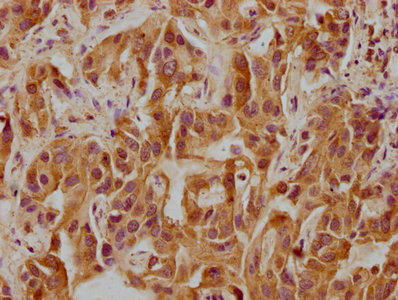Description
| Antibody Name: | CELSR3 Antibody (PACO62783) |
| Antibody SKU: | PACO62783 |
| Size: | 50ul |
| Host Species: | Rabbit |
| Tested Applications: | ELISA, IHC |
| Recommended Dilutions: | ELISA:1:2000-1:10000, IHC:1:200-1:500 |
| Species Reactivity: | Human |
| Immunogen: | Recombinant Human Cadherin EGF LAG seven-pass G-type receptor 3 protein (514-718AA) |
| Form: | Liquid |
| Storage Buffer: | Preservative: 0.03% Proclin 300 Constituents: 50% Glycerol, 0.01M PBS, pH 7.4 |
| Purification Method: | >95%, Protein G purified |
| Clonality: | Polyclonal |
| Isotype: | IgG |
| Conjugate: | Non-conjugated |
 | IHC image of PACO62783 diluted at 1:300 and staining in paraffin-embedded human liver cancer performed on a Leica BondTM system. After dewaxing and hydration, antigen retrieval was mediated by high pressure in a citrate buffer (pH 6.0). Section was blocked with 10% normal goat serum 30min at RT. Then primary antibody (1% BSA) was incubated at 4°C overnight. The primary is detected by a biotinylated secondary antibody and visualized using an HRP conjugated SP system. |
| Background: | Receptor that may have an important role in cell/cell signaling during nervous system formation. |
| Synonyms: | Cadherin EGF LAG seven-pass G-type receptor 3 (Cadherin family member 11) (Epidermal growth factor-like protein 1) (EGF-like protein 1) (Flamingo homolog 1) (hFmi1) (Multiple epidermal growth factor-like domains protein 2) (Multiple EGF-like domains protein 2), CELSR3, CDHF11 EGFL1 FMI1 KIAA0812 MEGF2 |
| UniProt Protein Function: | CELSR3: Receptor that may have an important role in cell/cell signaling during nervous system formation. Belongs to the G-protein coupled receptor 2 family. LN-TM7 subfamily. 2 isoforms of the human protein are produced by alternative splicing.Protein type: GPCR, family 2; Membrane protein, multi-pass; Membrane protein, integral; Receptor, GPCRChromosomal Location of Human Ortholog: 3p21.31Cellular Component: plasma membrane; integral to membraneMolecular Function: G-protein coupled receptor activity; protein binding; calcium ion bindingBiological Process: G-protein coupled receptor protein signaling pathway; regulation of protein localization; neuron migration; axonal fasciculation; cilium biogenesis; homophilic cell adhesion |
| UniProt Protein Details: | |
| NCBI Summary: | This gene belongs to the flamingo subfamily, which is included in the cadherin superfamily. The flamingo cadherins consist of nonclassic-type cadherins that do not interact with catenins. They are plasma membrane proteins containing seven epidermal growth factor-like repeats, nine cadherin domains and two laminin A G-type repeats in their ectodomain. They also have seven transmembrane domains, a characteristic feature of their subfamily. The encoded protein may be involved in the regulation of contact-dependent neurite growth and may play a role in tumor formation. [provided by RefSeq, Jun 2013] |
| UniProt Code: | Q9NYQ7 |
| NCBI GenInfo Identifier: | 145309304 |
| NCBI Gene ID: | 1951 |
| NCBI Accession: | NP_001398.2 |
| UniProt Secondary Accession: | Q9NYQ7,O75092 |
| UniProt Related Accession: | Q9NYQ7 |
| Molecular Weight: | Predicted Molecular Mass: 29.6kDaAccurate Molecular Mass: 29kDa as determined by SDS-PAGE reducing conditions. |
| NCBI Full Name: | cadherin EGF LAG seven-pass G-type receptor 3 |
| NCBI Synonym Full Names: | cadherin, EGF LAG seven-pass G-type receptor 3 |
| NCBI Official Symbol: | CELSR3 |
| NCBI Official Synonym Symbols: | FMI1; EGFL1; HFMI1; MEGF2; ADGRC3; CDHF11; RESDA1 |
| NCBI Protein Information: | cadherin EGF LAG seven-pass G-type receptor 3 |
| UniProt Protein Name: | Cadherin EGF LAG seven-pass G-type receptor 3 |
| UniProt Synonym Protein Names: | Cadherin family member 11; Epidermal growth factor-like protein 1; EGF-like protein 1; Flamingo homolog 1; hFmi1; Multiple epidermal growth factor-like domains protein 2; Multiple EGF-like domains protein 2 |
| Protein Family: | Cadherin EGF LAG seven-pass G-type receptor |
| UniProt Gene Name: | CELSR3 |
| UniProt Entry Name: | CELR3_HUMAN |






